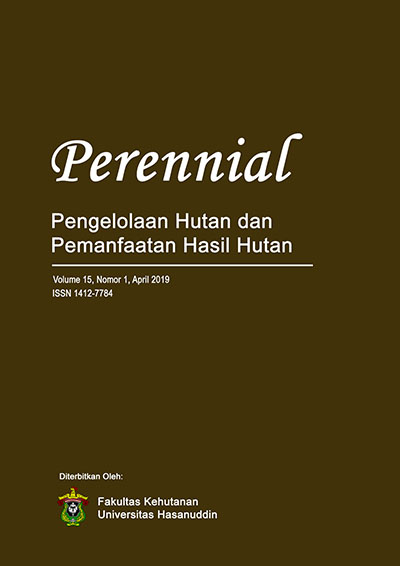ANALISIS TINGKAT KERAWANAN TANAH LONGSOR MENGGUNAKAN METODE FREKUENSI RASIO DI DAERAH ALIRAN SUNGAI BIALO
DOI:
https://doi.org/10.24259/perennial.v15i1.6317Keywords:
Abstract
Landslide is a movement of soil with slope direction and moves it on a slide. This study aimed to predict the landslide susceptibility map by using a frequency ratio. It used seven causative factors, such as slope, curvature, land use, lithology, distance to a river, distance to lineament, and rainfall. The result showed the AUC of success rate and predicted rate produced high accuracy with 0.907 and 0.904, respectively. According to the frequency ratio, the slope was the most influential than the other causative factors with 7.15. The landslide susceptibility divided into five classes, i.e. very low, low, moderate, high, and very high. Landslide susceptibility with very high and high was 19%. Moreover, classes susceptibility of very low, low, and moderate were 71%. The presentation of very high and high susceptibility is low, but it was located on an upper stream, and it will be a danger if to the downstream.Downloads
References
Aditian, A., & Kubota, T. (2017). The influence of Increasing Rainfall Intensity on Forest Slope Stability in Aso Volcanic Area, International Journal of Ecology and Development, Vol. 32, 1, 2017.01.
Arsyad, U., Barkey, R., Wahyuni, & Matandung, K. K. (2018). Karakteristik Tanah Longsor di Daerah Aliran Sungai Tangka. Jurnal Hutan dan Masyarakat, Vol. 10 (1): 203-214.
Badan Nasional Penanggulangan Bencana. (2018). Retrieved Oktober 27, 2018, from Data Informasi Bencana Indonesia (DIBI) Tahun 2013-2017: http://dibi.bnpb.go.id/dibi/
Djamaluddin, R. (2003). Fundamental study on application of unresin continuous carbon fiber reinforcing system to concrete structures. Institusi Nasional Informasi Scholary dan Navigator Informasi Akademik CiNii, 927-934.
Handayani, L., & Singarimbun, A. (2016). Pemetaan Daerah Rawan Longsor di Sekitar Daerah Prospek Panas Bumi Provinsi Jawa Barat. JoP, Vol. 2 N0. 1, November 2016, 17-22.
Hasnawir, Kubota, T., Sanchez–Castillo, L., & Soma, A. S. (2017). The Influence of Land Use and Rainfall on Shallow Landslides in Tanralili Sub–watershed, Indonesia. Journal Faculty Agriculture, Kyushu University, 62 (1), 171–176.
Nandi. (2007). Longsor. Bandung: Jurusan Pendidikan Geografi, FPIPS-UPI.
Nusantara, Y., & Setianto, A. (2015). Pemetaan Bahaya Tanah Longsor dengan Metode Frequency Ratio di Kecamatan Piyungan dan Pleret, Kabupaten Bantul, Daerah Istimewa Yogyakarta. Proceeding, Seminar Nasional Kebumian Ke-8 (15-16 Oktober 2015) (pp. 513-522). Academia-Industry Linkage; Graha Sabha Pramana.
Pradhan, B., & Lee, S. (2010). Landslide susceptibility assessment and factor effect analysis: backpropagation artificial neural networks and their comparison with frequency ratio and bivariate logistic regression modelling. Environmental Modelling & Software, 747-759.
Soma, A. S., & Kubota, T. (2017). The Performance of Land Use Change Causative Factor on Landslide Susceptibility Map in Upper Ujung-Loe Watersheds South Sulawesi, Indonesia. Journal of Geomatics and Planning, 157-170.
Sukamto, R., dan Supriatna, S., (1982). Peta Geologi Bersistem Lembar Ujungpandang, Benteng, dan Sinjai Sulawesi, Pusat Penelitian Dan Pengembangan Geologi, Bandung.
Tanika, L., Wijaya, C. I., Dwiyanti, E., & Khasanah, N. (2013). Peranan Lahan Berbasis Agroforestri Terhadap Neraca Air. Prosiding Seminar Nasional Agroforestri 2013, (pp. 328-334).



